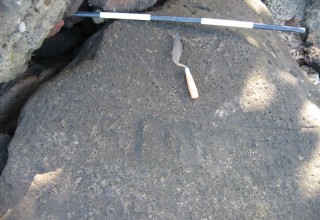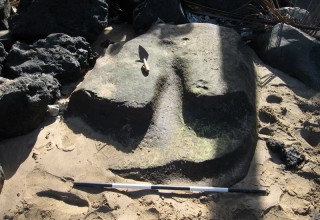Prehistoric Stone Features and World War II Artifacts Discovered in American Samoan Village
Archaeologists discover prehistoric stone features and World War II artifacts at Afao, a village in American Samoa, during an archaeological reconnaissance survey.
Online, October 26, 2012 (Newswire.com) - Territorial Archaeologist for American Samoa, Dr. Joel Klenck, discovered prehistoric stone features and World War II inscriptions on the coast at Afao, a village in American Samoa, during a reconnaissance archaeological survey. The historic features are located on the southwest coast of Tutuila, the largest island of American Samoa.
The survey was conducted to keep a U.S. Army Corps of Engineer's shoreline revetment project in compliance with a federal historic preservation law known as the National Historic Preservation Act. The Act requires that all federally funded projects take historic and archaeological sites into account by recording and avoiding damage to those sites whenever possible.. The American Samoa Coastal Zone Management Act also requires that construction projects in Territory be conducted in a manner to protect historic, cultural, and archaeological sites.
Some of the inscriptions from Afao appear to be from World War II as evidenced by their proximity to a Marine Corps camp during this era, two defensive fortifications at the site, subject matter of the inscriptions and the testimony of local villagers. The inscriptions from World War II were carved into a naturally occurring flat rock that was undercut by beach erosion. This basaltic promontory collapsed and was subject to further wave activity. Due to these environmental processes some of the inscriptions are barely visible while others portray clearer verbiage. According to the villagers from Afao, the inscriptions are from World War II. Also, units of the Marine Corps' 7th Defense Battalion bivouacked in Asili, an adjacent town less than a mile away from Afao. Further, two pill boxes from World War II are evidenced in this area. Inscriptions appear in the rocks in close proximity to the pill boxes and denote "USMC" [United States Marine Corps], a construction company and other verbiage.
Several grinding stones at Afao utilized by the early inhabitants of American Samoa are similar to those found at other sites with dates from prehistoric Samoan periods. One grinding stone, however, is unique and evidences a tripartite design that has not been reported in other South Pacific cultures. The function of the feature is unknown and various suggestions have been proffered by Felicia Beardsley, a professor of anthropology from the University of Laverne, including that the specimen resembles sakau sitting stones from Kosrae or might represent a "birthing stone." David Herdrich, the Director of the Historic Preservation Office of American Samoa, states, "A maternity stone is a possibility. One Samoan legend recorded by the German explorer, Augustin Kraemer, notes the story of the cultural hero, Tuiosavalalo, who was named after a beach rock, born on the coast, and suckled by fish. However, before we tender assertions we must look for other archaeological parallels to explain the function of this unique feature."
The World War II pill boxes Tutuila are tactically placed with one located directly in the center of the beach and the other positioned to the east further away from the coastline in heavy vegetation. The placement of these fortifications would have permitted cross fires on attacking enemy and a mutual defense along an expanse of shoreline that was very shallow at low tide. During World War II, Japanese landing craft would be blocked by the sudden elevation of the basaltic shelf several hundred meters from the shoreline and would then face weapons fire from one visible fortification and then another well-hidden pillbox toward the eastern edge of the shore..
Herdrich adds, "The excellent preservation of the defensive fortifications, which remain in their original positions, provides compelling evidence for the characteristics and tactical considerations of Marine Corps and Navy defensive structures during World War II."
The Afao site is partly enveloped by thick vegetation, leaf litter and canopy that most likely covered the area during World War II. The site incorporates a blending of ecological zones from a barren rocky coastline with large sand granules to a mixed disturbed upland forest consisting primarily of tropical plant life.
"The discovery is poignant," states Klenck, "A matai or chief, who was a young child at the time of World War II, noted that many Marines living on Tutuila, who were well-liked by the locales and protected American Samoa from a Japanese invasion, lost their lives during the War." The archaeologist concludes, "These inscriptions might represent the final visible testimonies of servicemen, who paid the ultimate sacrifice."
By Florence Aetonu-Teo, Historic Preservation Office




